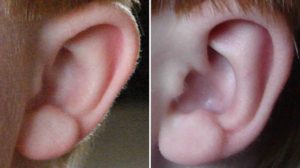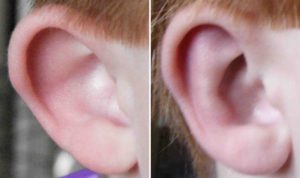Background: Correction of the protruding ear is the most common ear reshaping procedure done that involves cartilage manipulation. While it can be done at any age, it is perfectly acceptable to do otoplasty at a very young age. It has been shown that even as young as age two, no adverse long-term effects occur to ear growth from cartilage manipulation.
When performed at an early age (4 to 5 years of age), it is important to avoid cartilage resection or any other maneuvers that could create over correction or adverse scarring. Besides avoiding cartilage removal, limited postauricular skin resection should also be done. It has long been known that the success of otoplasty ultimately depends on what is done to the cartilage. Skin removal on the back of the ear does not contribute to pulling the ear backward.
Case Study: This young child (age 5) was brought in by his mother due to his protruding ears. Because he was to start school later in the year, she requested his protruding ears be pinned back to avoid ridicule.

Otoplasty in very young children can be done very effectively with suture techniques without cartilage excision or skin removal. Such a minimalistic approach is better for the growing ear and should strive to avoid over correction or unnecessarily removing tissues.
Case Highlights:
1) Otoplasty is often done in young cbildren to avoid being teased in school.
2) Younger otoplasties should be more minimalistic in technique focusing on suture methods.
3) Skin resection on the back of the ear has a minimal role to play in otoplasty correction.
Dr. Barry Eppley
Indianapolis, Indiana



